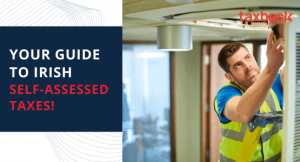Irish Payslips - What You Need to Know
All you need to know on payslips to avoid nasty surprises down the line!
Read the updated article here
Most employees across the country will at this stage have received their first payslip for 2013 (for many it is probably spent at this stage too!) Surveys have demonstrated that the majority of Irish employees do not examine their payslips and are only concerned if they notice an unexplained drop in their take home pay. However, at Taxback.com we are encouraging employees across the country to be more careful as not checking your payslip can have huge consequences down the line.
2013 changes
The good news for 2013 is that there were no increases in tax rates and no reduction in bands and credits. That is, unfortunately, where the good news ends – as we had feared, the dreaded property tax came to fruition in 2013 and at this stage many people are anxiously awaiting their Revenue estimate, which we expect will issue between early March and early April. With regard to the pay packet, even though we may have been lulled into a false sense of security by the unchanged tax credits and bands, all employees earning over €18,000 will have noticed a drop in their take home pay of €5 per week or €22 per month. This is due to a change in the PRSI rules.
Further reductions to the take home pay will of course be on the cards for those home owners opting to pay their property tax via their employers. The tax will have to be paid one way or another so, whether it comes from the pay packet or by other means, it will have a net effect on the money in your pocket.
How it all works – PAYE system
Employers are obliged to apply PAYE to their employees’ pay based on the information provided by Revenue i.e. the employee’s tax credit certificate. However, the tax credit certificate issued by Revenue is determined by the information which Revenue holds in respect of that employee. Revenue may not have the most up to date information in respect of an individual’s personal status (marital, parental etc) at the time that they issue the tax credit certificate and this can result in an incorrect allocation of credits and bands.
Year end overpayments
This can often mean that an individual pays more tax than they should have as Revenue has not allocated them with the correct credits. The additional relief can then be claimed at the end of the year, resulting in a refund. This is generally a very nice result for the individual concerned. Note – you need to make a claim to get this money back – Revenue won’t know that you are entitled to the additional relief unless they are informed of the change in your circumstances.
Year end underpayments
However, a more worrying situation for people can arise if they have been allocated with tax credits that they are not entitled to. If this happens to an individual, they will have an underpayment at the end of the year and Revenue will generally seek to collect this over the course of the following year by making an adjustment to the employee’s tax credits. But what does that mean? This means that the employee’s take home pay each week/month will be reduced until such a time as the underpayment has been settled. Even more concerning for people in this situation is that sometimes the underpayment may not be noted by Revenue for a number of years and then the taxpayer is faced with a greater underpayment which will take longer to repay. The reduction in take home pay can be very worrying for people, as these days most do not have any money to spare.
The average Irish tax refund is €1,880
Automatic carry forward of credits/ Revenue allocation of credits
Each year, when Revenue issues tax credit certificates certain items will be automatically carried forward from the prior year, for example Rent credit, home carer credit, one parent family credit, flat rate expenses and the married band. This is usually very helpful for the taxpayer as it means that people don’t have to constantly re apply for these reliefs. However, sometimes an individual’s circumstances will have changed. For example, they may have moved job and may no longer be entitled to the flat rate expenses relief. Similarly, an individual who was previously a home carer may have started working on a self employed basis.
If Revenue has e not been advised of these type of changes they will not be aware of them and will continue to allocate the credits and reliefs which applied previously. At a later stage, when Revenue becomes aware of these changes, they will issue a notification to the individual stating the amount underpaid and advising how they will collect it. It is very important to note that even though you are a PAYE employee whose employer deducts the tax from your salary each month, it is each individual’s personal responsibility to ensure that they have paid the correct tax. Therefore, while Revenue does not generally impose any penalties on people in these circumstances, there is no argument to be made that you were entitled to the relief purely because it was included in your tax credit certificate.
Your payslip explained
Before you start to frantically hunt around the house for your tax credit certificate (most people cannot find them as they tend to grow legs and walk!) stop and take a look at your most recent payslip instead. This will probably give you enough information in order to determine whether or not you need to be concerned. On your payslip you should see the following if you are monthly paid (if weekly paid, replace the word monthly with weekly):
- Monthly Tax Credit
- Monthly Cut Off
These are the important items for you to check.
The average Irish tax refund is €1,880
Monthly Tax Credit
Each individual is entitled to certain tax credits which are based on their personal circumstances. The tax credits are allocated on an annual basis; they are added up and then divided on a monthly or weekly basis depending on how you are paid.
Monthly Cut Off
This is the amount you can earn each month before you will have to pay the higher rate of tax, i.e. anything you earn up to this amount is taxed at 20% and anything you earn over this amount is taxed at 41%. Let’s take some simple examples to illustrate how this works.
Example 1
Mary is single, has no children and lives with her parents. She is a secondary school teacher. Mary is entitled to the following in 2013:
- Personal Tax Credit: €1,650
- PAYE Tax Credit: €1,650
- Flat Rate Expenses: €518
- Cut Off point: €32,800
- Flat rate expenses are essentially a deduction from taxable income and therefore are a little complex in the way that they feature on a tax credit certificate/payslip.
- Mary’s annual tax credit is €3,403.60 ((1650 X2) + (518X 20%))
- Mary’s annual Cut Off Point is €33,318 (32,800 + 518)
- Mary’s monthly tax credit is €283.63
- Mary’s monthly Cut Off Point is: €2,776.50
Example 2
This time let’s assume Mary is a private sector worker with no entitlement to flat rate expenses:
- Mary’s annual tax credit is €3,300 (1650 X2)
- Mary’s annual Cut Off Point is €32,800
- Mary’s monthly tax credit is €275
- Mary’s monthly Cut Off Point is €2,733.33
Example 3
This time let’s assume that Mary is a married, private sector worked with no entitlement to flat rate expenses and her husband stays at home to take care of their two children: Mary is entitled to the following in 2013:
- Personal Tax Credit €3,300
- PAYE Tax Credit €1,650
- Home Carer Credit €810
- Cut Off point €32,800
- Mary’s annual tax credit is €5,760 (3300 + 1650 +810)
- Mary’s annual Cut Off Point is €41,800
- Mary’s monthly tax credit is €480
- Mary’s monthly Cut Off Point is €3,483.33
Free PDF guide to PAYE taxes in Ireland
Take Action Now
If you can’t find your January payslip now, don’t worry. When you get your next payslip, check out what it says in respect of your monthly/weekly tax credit and cut off point. Multiply this by 12 or 52 to determine your annual tax credit and cut off point. The most common tax credits and cut off points are:
| Category | Credit | Cut off |
| Single person or married person both spouses working | 3,300 | 32,800 |
| Married person one spouse working (with kids) | 4,950 | 41,800 |
| Married person one spouse working (without kids) | 5,760 | 41,800 |
If your tax credits are higher or lower than this there will be a reason and you need to make sure that you understand this reason. If you request a copy of your tax credit certificate from Revenue they will send you a copy, which will spell out any adjustments to the above. If you see that you are receiving items that you are not entitled to, contact Revenue to have this amended and avoid having a liability at a later date!




